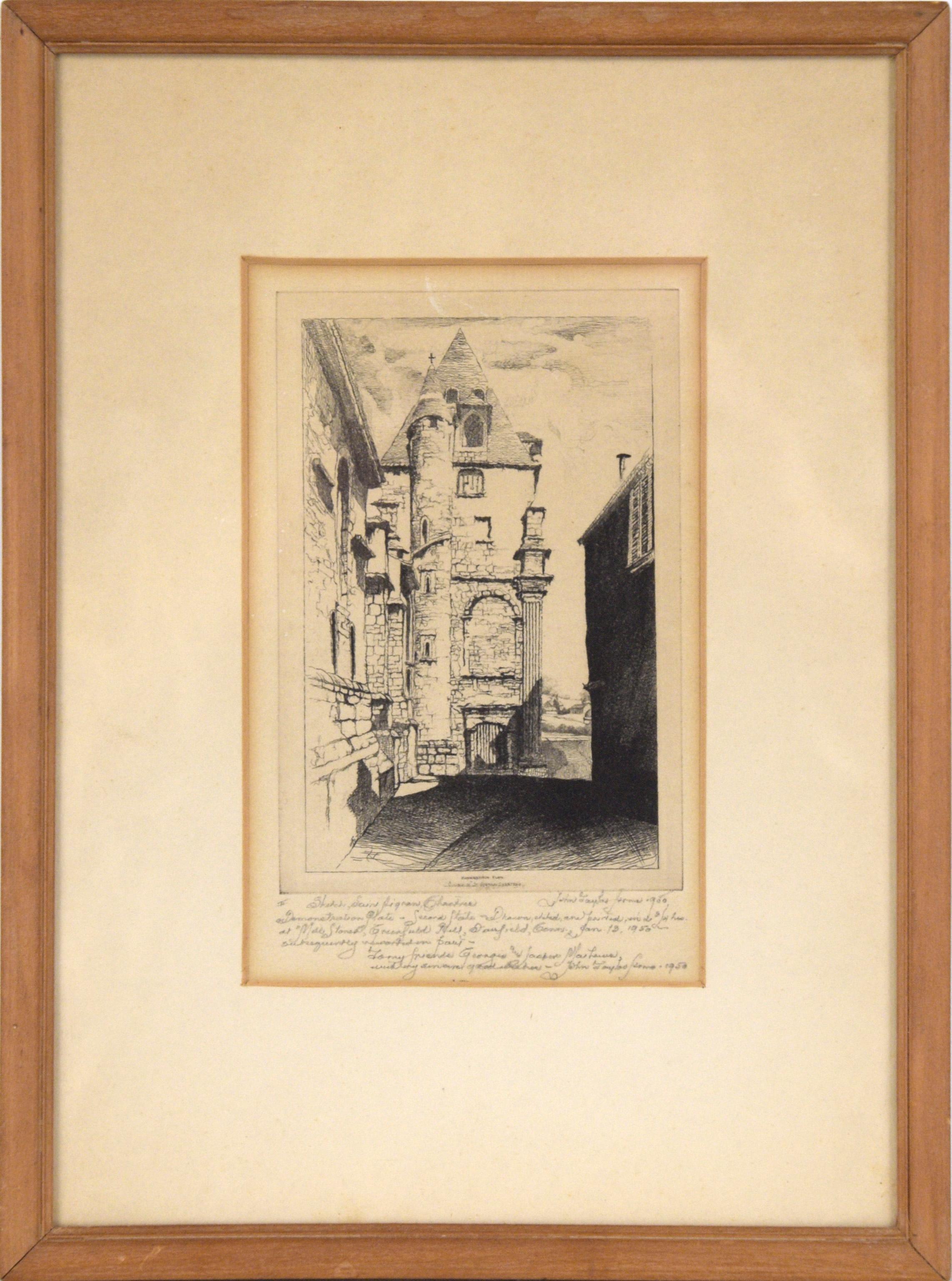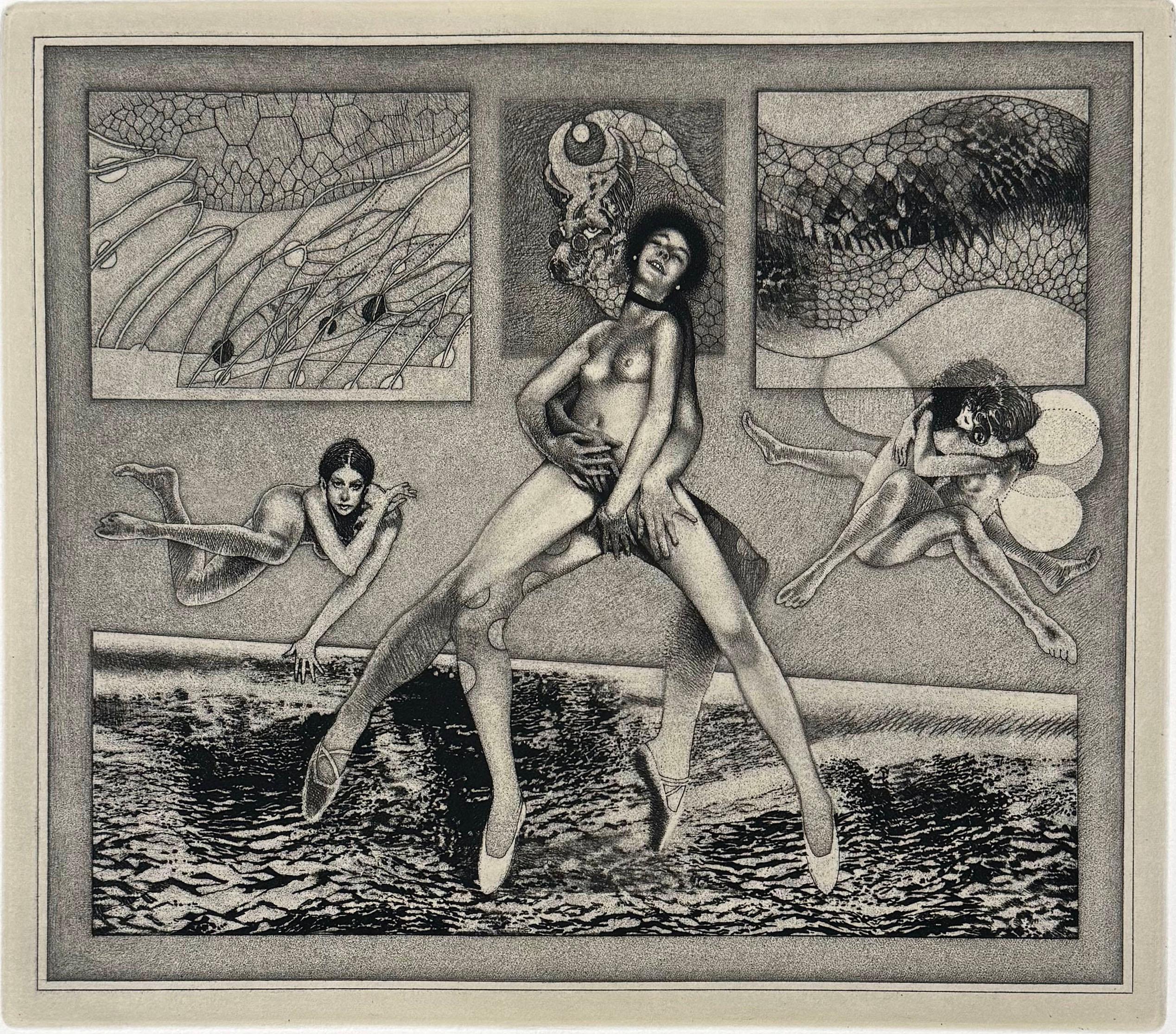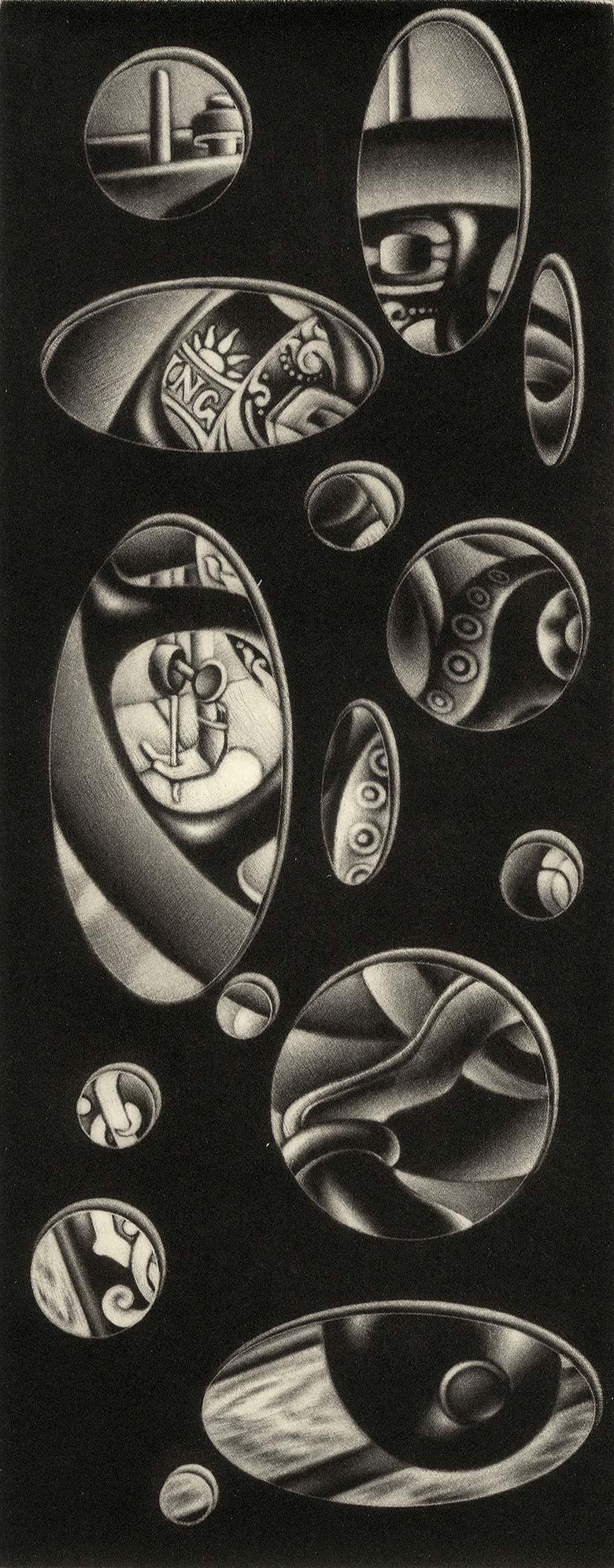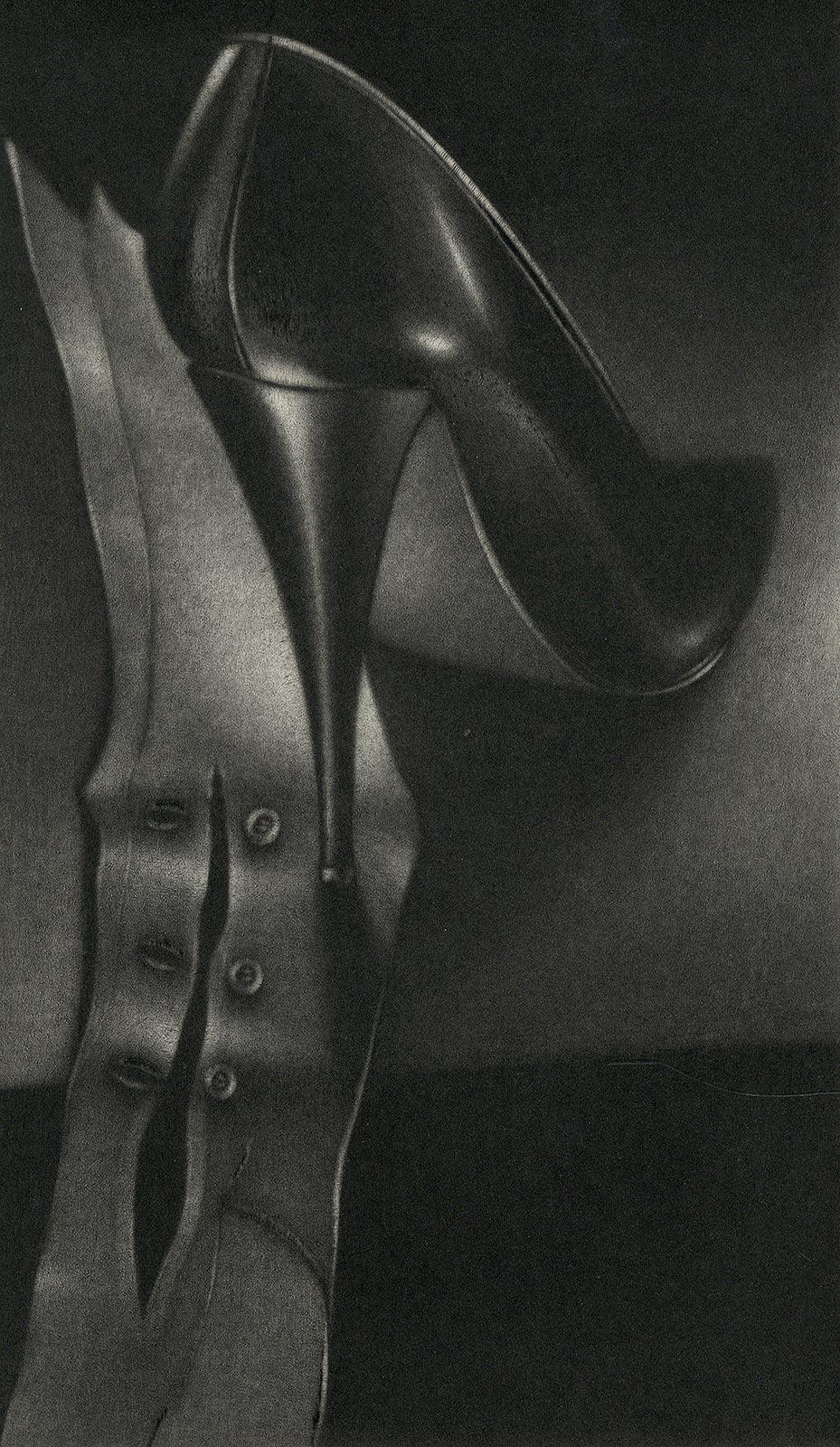Items Similar to Three 19th C. Engravings of Classical Italian Bronze Architectural Elements
Want more images or videos?
Request additional images or videos from the seller
1 of 20
UnknownThree 19th C. Engravings of Classical Italian Bronze Architectural Elements1889
1889
About the Item
A grouping of three engravings depicting classical Italian architectural features held in the National Museum of Naples, entitled "Bronze Hydria", "Marbre Naissance de Bacchus" and "Bronze Trepied Pour Sacrifice" from "Specimens from the Naples Museum : one hundred and sixty-eight plates, engraved on copper by the best Italian artists, illustrating four hundred and sixty-six objects from every branch of art and archaeology", published in Naples in 1889. These were created by artists F. Mori, P. Amendole and R. Radente.
"Marbre Naissance de Bacchus", Fig. 68: Top; The ancient Greek "Gaeta" Vase which depicts in bas-relief Mercury giving the infant Bacchus to the nymph Nisa. Bottom; A large vat adorned with bas-reliefs of Jupiter with his eagle, Hercules with his club, Mercury with his caduceus are visible and around other portions of the structure but not visible are Mars with a lance, Apollo with a lyre, Aesculapius with his staff and serpent and Bacchus with thyrsus and cantharus.
"Bronze Trepied Pour Sacrifice", Fig. 120 A beautiful tripod with three lion-footed legs capped by a seated sphinx and adorned with decorative arabesques and bearded heads of Jupiter Ammon. The legs are braced by elegant sprays of lotus and a lotus bud. The tripod is also called the Tripod of Isis and was meant for the worship of the Egyptian god Isis. It was found in a private house in Herculaneum.
"Bronze Hydria", Fig. 144 A pail richly embossed and inlaid in silver. The handles are hinged and form a rim to the pail when they are in the down position. One of the handles has the inscription " Corneliae S. Chelidonis".
The prints are presented in identical gold-colored wood frames with decorative textured gold-colored mats and gold fillets. Each frame measures 14.75" x 12.5" x 2".
- Creation Year:1889
- Dimensions:Height: 14.75 in (37.47 cm)Width: 12.5 in (31.75 cm)Depth: 2 in (5.08 cm)
- Medium:
- Period:
- Condition:
- Gallery Location:Alamo, CA
- Reference Number:
About the Seller
5.0
Vetted Seller
These experienced sellers undergo a comprehensive evaluation by our team of in-house experts.
Established in 2011
1stDibs seller since 2019
233 sales on 1stDibs
Typical response time: 1 hour
- ShippingRetrieving quote...Ships From: Alamo, CA
- Return PolicyA return for this item may be initiated within 7 days of delivery.
More From This SellerView All
- Marquis de Marigny: An 18th C. Wille Engraved Portrait after a Tocque PaintingBy Louis TocquéLocated in Alamo, CAThis is a mid 18th century engraved portrait of Abel François Poisson de Vandières, Marquis de Marigny by Jean Georges Wille after a painting by Louis Tocque...Category
Mid-18th Century Portrait Prints
MaterialsEngraving
- N. Lambert Seigneur de Thorigny: 17th C. Engraved Portrait After LargillièreBy Nicolas de LargillièreLocated in Alamo, CAThis is a 17th century engraving entitled "Messire Nicolas Lambert Seigneur de Thorigny, Conseiller du Roy" by Pierre Drevet after a painting by Noicolas de Largillière, published in Paris in 1698. This portrait depicts a three-quarter length view of Nicolas Lambert de Thorigny, who is dressed in elaborate robes and collar of a wealthy Parisian nobleman of the time. He is seated directed to the left and looking directly at the viewer. He is holding an inscribed note in his right hand. A magnificent billowing curtain is in the background. Lambert's coat of arms is shown in the center of the lower inscription area. In the inscription area is lettered with title, production detail: "Nic. Largilliere pinxit" and "Petr. Drevet sculpsit", and publication detail: "Se vend a Paris chez Drevet rüe du Foin au coin du College de Maître Gervais". Nicolas Lambert, Seigneur de Thorigny (1600-1664), was a French nobleman and military commander who lived in the 17th century. He served in the French army during the Thirty Years' War, a conflict that took place from 1618 to 1648 and involved many European powers. Lambert fought in several battles during the war and rose to the rank of colonel. After the war, Lambert returned to France and became involved in politics. He served as a member of the Estates General, a legislative body that advised the king, and as a governor of several provinces. He was a counsellor and confidant of King Louis XIV. He had the title of Président de la Chambre des Comptes. He also became a member of the French Academy of Sciences, a prestigious institution that promotes scientific research and scholarship. Lambert was known for his military expertise, his intelligence, and his commitment to public service. He iInherited the Hôtel Lambert in Paris from his brother Jean Baptiste in 1644 and hired some of the most prominent artists of the time, including Charles Le Brun to decorate and furnish the building. This beautiful old master engraving was created with impressive detailed technique. It is printed on laid, chain-linked paper. The sheet measures 18.5" high and 13.38" wide. The sheet is adhered to an archival backing paper at the top. There is a faint horizontal center fold and mild discoloration in the inscription area and in the upper margin on the right, with mild wrinkling here. The print is otherwise in very good condition, considering its age. This engraving is so rare, that no comparable prints could be identified for sale online. It is currently only listed in museum collections, including: The Metropolitan Museum of Art, The British Museum, The Louvre, The Riksmuseum, The Victoria & Albert Museum, The Fitzwilliam Museum at the U. of Cambridge, The Boston Museum of Fine Arts, Harvard Art Museums, The Finnish National Museum, The Philadelphia Museum. It is shown in the Metropolitan Museum's Cataloque of French paintings entitled: "French Paintings in The Metropolitan Museum of Art, published in 2018, page 36. The page is included in the photos. Nicolas de Largillière (1656-1746) was a French portrait painter who achieved great success and acclaim during the late Baroque and Rococo periods. He was born in Paris and trained under the painter Antoine Goubeau. He studied in Antwerp and London before returning to France. While in England he was a favorite painter of King Charles II and King James II of England...Category
Late 17th Century Portrait Prints
MaterialsEngraving
- The Duchess of St. Albans: A 17th C. Portrait After a Kneller PaintingBy (After) Sir Godfrey KnellerLocated in Alamo, CAThis is a 17th century engraved mezzotint portrait of the Duchess of St. Albans by John Smith, after a painting by Sir Godfrey Kneller. It was published in London by John Boydell in 1694. The Duchess of St. Albans (1642-1712) was a woman named Diana de Vere. She was born in 1642, the daughter of Aubrey de Vere, the 20th Earl of Oxford. In 1662, she married Charles Beauclerk, the illegitimate son of King Charles II and his mistress, Nell Gwyn. As a result of her marriage, Diana became the Duchess of St. Albans, and she and Charles had several children together. Diana was known for her beauty and charm, and she was a prominent figure in the court of King Charles II. Despite her husband's illegitimate birth, Diana was highly respected in the royal court and was known for her intelligence and wit. She was a patron of the arts and supported many artists and writers of the time. Diana lived through a tumultuous period of English history, including the Great Fire of London and the Glorious Revolution, which saw King James II replaced by William of Orange. She died in 1712 at the age of 70 and was buried in Westminster Abbey. Descendants of Diana and her husband, who was an illegitimate son of King Charles II, include Diana, Princess of Wales and her son William, Duke of Cambridge. An author wrote of her: "The line of Vere, so long renown’d in arms, Concludes with luster in St. Albans’s charms; Her conquering eyes have made their race complete, It rose in valor, and in beauty set." This striking mezzotint engraving depicts Diana, Duchess of St Albans in a three-quarter length pose, standing, wearing loose flowing dress and a wrap. She has a very serene, calm appearance as she is looking straight at the viewer. There is a landscape of trees in the background. The print is adhered in the corners to an archival backing, which is itself adhered in the upper corners to a larger backing. The print is trimmed to just beyond the plate mark. There are areas of discoloration in the margins and in the inscription area, but the print is otherwise in very good condition. The sheet measures 14.5" high and 10" wide. This mezzotint is held by multiple museums and institutions, including The British Museum, The National Portrait Gallery London, The Fine Arts Museum of Boston, The Lewis Walpole Library at Yale, The Yale Center for British Art, The Fitzwilliam Museum at Cambridge and The National Galleries of Scotland. The original Kneller painting is part of the British Royal Collection Trust and hangs in the King's Private Dining Room at Hampton Court Palace. Sir Godfrey Kneller (1646-1723) was a leading portrait painter of his time, particularly renowned for his depictions of the British aristocracy and royalty. He was born in Lübeck, Germany, and trained in Amsterdam under the painter Ferdinand Bol...Category
Late 17th Century Portrait Prints
MaterialsMezzotint
- Elizabeth, Countess of Northumberland: Mezzotint After a Painting by J. ReynoldsBy Joshua ReynoldsLocated in Alamo, CAThis is an 18th century mezzotint portrait of Elizabeth, Countess of Northumberland, Baroness Percy by Richard Houston after a painting by Joshua Reynolds, published in London by Robert Sayer in 1763. It is a rare, full length portrait of Elizabeth, who was known as Lady Betty. Lady Betty stands, facing to the right, holding her coronet, and wearing her peeress’s ermine and velvet robes over a brocade dress. In the background are a column, a billowing drape, and the grounds of Alnwick Castle...Category
Mid-18th Century Portrait Prints
MaterialsMezzotint
- Loggie di Rafaele nel Vaticano: 18th Century Hand-colored Engraving by VolpatoBy Giovanni VolpatoLocated in Alamo, CAThis is an original 18th century hand-colored copper-plate engraving by Giovanni Volpato after a drawing by Camporesi. It was the frontispiece for volume one of the rare and valuable...Category
Late 18th Century Old Masters Interior Prints
MaterialsEngraving
- Richard Reynolds, Society of Friends: 19th C. Engraved Portrait by Wm. SharpBy William SharpLocated in Alamo, CAThis is an early 19th century engraved portrait of the industrialist and philanthropist Richard Reynolds by William Sharp after William Hobday. It was published in London by Rudolph Ackerman in 1817. The print is entitled "Richard Reynolds of the Society of Friends, Late of Bristol". This three-quarter length portrait of Reynolds depicts him seated, directed to right, looking towards the viewer. He is holding an open book, wearing a plain suit. A curtain in the background is pulled to the left, revealing bookshelves. Some of the books are labelled 'Addison & Watts' 'Kempis & Fenelon' 'Milton & Cowley' etc. The inscription above the portrait reads: "When the eye saw him it blessed him". The lettering below the image reads: "Richard Reynolds of the Society of Friends, Late of Bristol; Whose Life and Fortune were devoted to the Glory of God by relieving the humble in Distress.', This plate is dedicated by Permission to his Royal Highness, the Prince Regent by his most devoted very humble servant William Hobday." This engraving is printed on thick paper. The sheet measures 16" high and 12" wide. It is adhered to an archival backing in the upper left corner. There is mild discoloration and toning in the margins, but it does not involve the image. Richard Reynolds (1735-1816) was a prominent member of the Society of Friends, also known as Quakers, in the 18th and 19th centuries. He was born into a wealthy family in Bristol, England, and inherited a successful copper smelting, iron manufacturing business from his father. Despite his privileged upbringing, Reynolds was known for his deep concern for the poor and his commitment to social justice. He used his wealth and influence to support a range of philanthropic causes, including the abolition of slavery, the improvement of working conditions for miners and factory workers, and the provision of education for the poor. Reynolds was also a prominent supporter of the Quaker...Category
Early 19th Century Portrait Prints
MaterialsEngraving
You May Also Like
- "Dark Box" Drypoint Etching with Aquatint (no. 10/20)Located in Soquel, CAFinely balanced etching by Benjamin Vasserman (Estonian, b 1949). A squash sits atop a small black box with a latch. There is a drapery behind the squa...Category
1980s Modern Interior Prints
MaterialsInk, Aquatint, Drypoint, Paper
- "Still Life with Door", Monochrome Cyan Drypoint EtchingBy Barbara B. CohnLocated in Soquel, CALimited edition monochrome cyan drypoint etching of a potted plant and door by Barbara Cohn (American, 1923-2019). Numbered ("2/25"), titled ("Still Life with Door"), and hand signed...Category
1980s American Realist Still-life Prints
MaterialsPaper, Ink, Drypoint
- "Church of St. Aignan Chartres" Etching in Ink on Paper (Demonstration Plate)By John Taylor ArmsLocated in Soquel, CA"Church of St. Aignan Chartres" Etching in Ink on Paper (Demonstration Plate) Delicate and detailed drypoint etching of the Church of St. Aignan in Chartres, France by John Taylor Arms (American, 1887-1953). The viewer stands in an alley near the church, looking out of the shadows at the sunlit towers. The architectural details of the church are well-captured, including the texture of the stone walls, the roof, and ornamental detail. Titled, signed, dated, and inscribed along the bottom edge: Sketch, Saint Aignon, Chartres John Taylor Arms 1950 The inscription includes details about production, as well as a dedication "To my friends Georgia and Jasper Mathews, with my sincerest good wishes" Presented in a wood frame with an off-white mat. Frame size: 12.5"H x 9.25"W Image size: 7"H x 4.5"W John Taylor Arms was born in Washington, DC in 1887. He studied law at Princeton University, transferring to the Massachusetts Institute of Technology, Boston, to study architecture, graduating in 1912. After serving as an officer in the United States Navy during World War I, he devoted himself full-time to etching. He published his first original etchings in 1919. His initial subject was the Brooklyn Bridge in New York City near which he worked. Arms developed a successful career as a graphic artist in the 1920s and 1930s, specializing in series of etchings of Gothic churches and cathedrals in France and Italy. In addition to medieval subjects, Arms made a series of prints of American cities. He used sewing needles and magnifying glasses to get a fine level of detail. A member of many printmaking societies, Arms served as president of the Society of American Graphic Artists. An educator, Arms wrote the Handbook of Print Making and Print Makers (1934) and did numerous demonstrations and lectures. Arms was elected into the National Academy of Design as an Associate member in 1930, and became a full member in 1933. His work was also part of the painting event in the art competition at the 1932 Summer Olympics...Category
1940s Victorian Still-life Prints
MaterialsInk, Etching, Drypoint, Paper
- Europa, by Peter MiltonBy Peter MiltonLocated in Palm Springs, CAResist Ground Etching and Engraving from a Copper Plate on BFK Rives, Somerset Buff, Wove Paper Medium: Resist Ground Etching & Engraving Edition of 125 Year: 1982 One o...Category
1980s Contemporary Interior Prints
MaterialsEtching, Engraving
- Singer 10101By Carol WaxLocated in New Orleans, LACarol Wax's mezzotint, "Singer 10101", is an image of Singer I as seen through a drafting template. It was issued as an edition of 40 and was printed at the Indiana University print...Category
Early 2000s Contemporary Still-life Prints
MaterialsMezzotint
- Le Talon Aigviille (Marlene Dietrich's Stiletto Heel -- In time for PRIDE)By Laurent SchkolnykLocated in New Orleans, LAThis mezzotint was created by Laurent Sckolnyk and was meant as an homage to the movie stars of yesteryear -- in this case Marlene Dietrich. Dietrich was an icon in the gay community...Category
Late 20th Century Contemporary Still-life Prints
MaterialsMezzotint
Recently Viewed
View AllMore Ways To Browse
Antique Architectural Elements
Bronze Architecture
Four Engravings
Italian Wood Architectural Elements
Lion Footed
Bronze Head Italian
Italian Bronze Head
Bronze Framed Plate
19th Architecture Engraving
Antique Copper Still
Antique Copper Stills
Copper Still Antique
Bronze Head Classical
Framed Lotus
Italian Fig
Large Bas Relief
Bronze Sphinx
Apollo 19th





